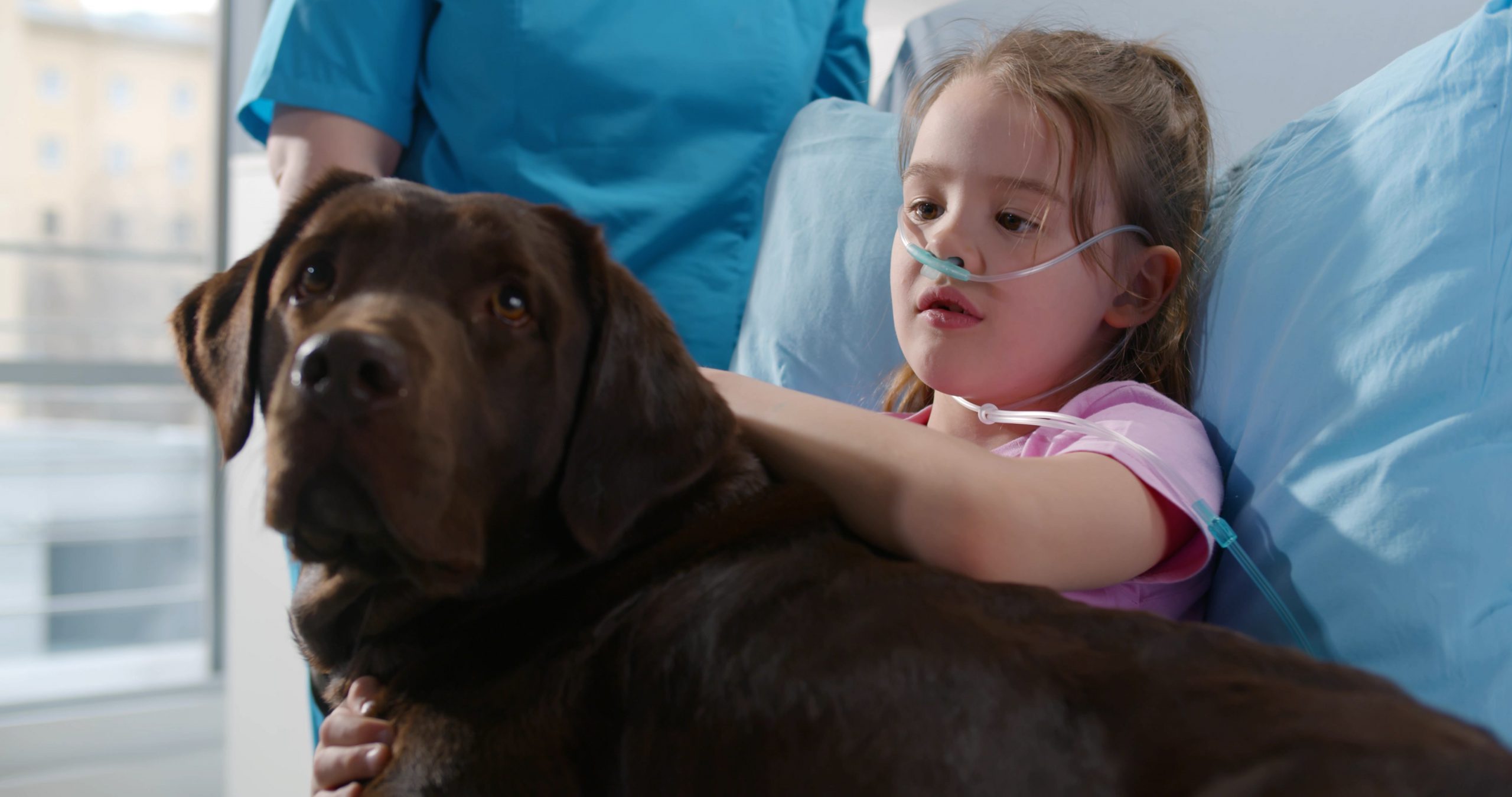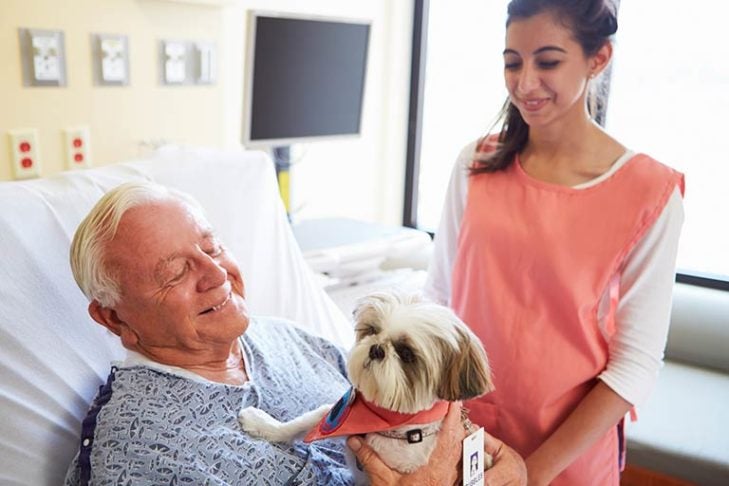To train your dog to be a therapy dog, start with basic obedience training. Gradually introduce them to different environments and people to build their social skills.
A well-rounded introduction would cover the benefits of therapy dogs, the qualities needed in a therapy dog, and the necessary steps to train a dog for therapy work. Therapy dogs provide comfort and support to people in need, such as patients in hospitals, schools, and nursing homes.
Dogs that are calm, friendly, and obedient are suitable candidates for therapy work. Training involves obedience commands, exposure to various environments, and practicing good behavior around people. Additionally, registration and certification may be required for a dog to become a recognized therapy dog. By understanding the process and commitment involved, owners can successfully train their dogs to become valuable therapy companions.
The Benefits Of Training Your Dog As A Therapy Dog
The Benefits of Training Your Dog as a Therapy Dog
Training your dog to be a therapy dog can have a profound impact on both you and those around you. Not only does it provide an opportunity to develop a stronger bond with your furry friend, but it also opens the door to making a positive difference in the lives of others.
Improving The Lives Of Others
Therapy dogs play a crucial role in improving the lives of individuals in need. Whether they are comforting patients in hospitals or providing support to those with mental health conditions, these well-trained dogs bring joy, comfort, and companionship to those who need it most. Research has shown that interacting with therapy animals can help reduce stress, alleviate feelings of loneliness, and improve overall well-being. These dogs truly have the power to brighten someone’s day and make a significant impact on their quality of life.
Promoting Emotional Well-being
The presence of a therapy dog can have a positive effect on emotional well-being. Interacting with these gentle and loving animals can help individuals feel more calm, relaxed, and content. Therapy dogs provide a source of unconditional love and support, which can be particularly beneficial for those struggling with depression, anxiety, or other mental health conditions. Simply petting or cuddling with a therapy dog can release endorphins, known as the “feel-good” hormones, and help uplift mood. The comforting presence of a therapy dog can provide solace during difficult times and serve as a reminder that they are not alone.
Enhancing Social Skills
Training your dog as a therapy dog can also enhance social skills and promote socialization. Therapy dogs often visit various settings such as schools, nursing homes, or rehabilitation centers, providing opportunities for individuals to interact and engage in meaningful conversations with others. Through these interactions, individuals may experience increased self-confidence, improved communication skills, and a sense of belonging. Furthermore, therapy dogs can help break down barriers and promote inclusion, as they do not judge or discriminate against anyone. They accept people for who they are and provide a source of comfort and acceptance.
Whether you are looking to make a difference in the lives of others, promote emotional well-being, or enhance social skills, training your dog as a therapy dog can be a rewarding and fulfilling experience. The benefits extend beyond just the training process, as the impact they have on the individuals they encounter is immeasurable. By creating a strong bond with your dog and working together to bring joy to others, you are not only making the world a better place, but also experiencing the joy and fulfillment that comes with being a therapy dog handler.
Understanding The Qualities Of A Good Therapy Dog
Training your dog to become a therapy dog involves understanding the qualities required, such as calmness, obedience, and sociability. Teaching your dog the necessary skills and exposing them to different environments can help them excel in comforting and supporting others in need.
Temperament
A good therapy dog should have a calm and gentle temperament. They need to be friendly, patient, and adaptable to various environments and people.Obedience
Therapy dogs require a high level of obedience and responsiveness to commands. They should be well-trained and able to follow instructions consistently, ensuring they can behave appropriately in different situations.Good Health
A good therapy dog should be in good physical health. Regular exercise, proper grooming, and routine veterinary care are essential to maintain a therapy dog’s well-being and ability to provide comfort to others.Basic Training For Your Dog
Training your dog to become a therapy dog requires a solid foundation in basic obedience and socialization. Before engaging in specialized therapy training, it’s essential to ensure that your dog responds reliably to basic commands, is well-socialized with people and other dogs, and can handle distractions with ease.
Teaching Basic Commands
Teaching your dog basic commands such as “sit,” “stay,” “come,” and “heel” is fundamental in therapy dog training. Consistent and patient training with positive reinforcement is key to instilling these commands in your dog’s behavior.
Socializing Your Dog
Socialization plays a crucial role in shaping your dog’s behavior. Exposing your dog to various environments, people, and other animals helps in developing their confidence and adaptability, which are highly valued traits in therapy dogs.
Handling Distractions
Training your dog to maintain focus in the presence of distractions is essential for therapy work. Gradually introduce distracting stimuli during training sessions and reinforce your dog’s ability to remain attentive and responsive in these situations.

Credit: www.thefarmersdog.com
Specialized Training For Therapy Work
Looking to train your dog to become a therapy dog? Our specialized training program offers the tools and techniques needed to prepare your furry friend for this important role. With our expert guidance, your dog will be equipped to bring joy and comfort to those in need.
Becoming a therapy dog requires specialized training to ensure they are prepared for their important role. This training involves introducing the dog to people and medical equipment, building their confidence in different environments, and teaching them therapy-specific skills. Let’s dive into the details of each aspect of specialized training for therapy work.
Introduction To People And Medical Equipment
To be an effective therapy dog, your furry friend should undergo proper training to feel comfortable around people and various types of medical equipment. Familiarizing them with different individuals, such as children, senior citizens, and people with disabilities, can help them become more accustomed to diverse social interactions.
Furthermore, exposing your dog to medical equipment like wheelchairs, walkers, and crutches can help desensitize them to these objects, making them less anxious or fearful during therapy sessions. The trainer will guide them through encounters with these items, ensuring they respond calmly and confidently.
Building Confidence In Different Environments
Therapy dogs need to be adaptable and at ease in different environments, including hospitals, schools, and nursing homes. Training should involve gradually exposing your dog to new places, allowing them to acclimate to the sights, sounds, and smells they may encounter during therapy sessions.
Simulating these environments and introducing distractions, such as loud noises or unusual scents, can help your dog maintain focus and remain calm during therapy visits. Consistent exposure to such scenarios will build their confidence, enabling them to perform their therapy duties with ease.
Learning Therapy-specific Skills
Once your dog has a solid foundation of basic training, it’s essential to teach them therapy-specific skills. These will vary depending on the type of therapy work they will be involved in. Some common therapy-specific skills include:
| Therapy-specific Skills |
|---|
| Sit, stay, and come on command |
| Walking calmly on a leash without pulling |
| Being comfortable with physical contact from strangers |
| Remaining calm during sudden movements or loud noises |
| Responding to basic medical commands, such as “paw” or “nose” |
Consistent practice of these skills will polish your dog’s abilities and ensure they can perform their therapy duties with confidence and gentleness. Regular training sessions will also help reinforce these skills, keeping them sharp and ready for any therapy session.
Remember, specialized training for therapy work is crucial to equip your dog with the necessary skills and confidence they need to become a valuable therapy dog. By introducing them to people and medical equipment, building their confidence in different environments, and teaching them therapy-specific skills, you are paving the way for a successful therapy dog career.
Certification And Volunteering Opportunities
Discover certification and volunteering opportunities to train your dog as a therapy dog. Gain valuable experience and skills while making a positive impact in your community. With the right training, your furry friend can provide comfort and support to those in need.
Dogs have a unique ability to bring joy and comfort to others, making them excellent candidates for therapy work. If you’re interested in turning your furry friend into a therapy dog, certification is an essential step. In this article, we will explore the process of finding a certified therapy dog program, preparing for the certification process, and exploring volunteer opportunities.Finding A Certified Therapy Dog Program
If you’re considering turning your dog into a therapy dog, finding a certified therapy dog program should be your first priority. These programs are specifically designed to train dogs and their handlers to navigate various therapy situations and ensure they meet the necessary standards. Some reputable organizations that offer certified therapy dog programs include:- Therapy Dogs International (TDI)
- Alliance of Therapy Dogs (ATD)
- Bright and Beautiful Therapy Dogs
Preparing For The Certification Process
Once you’ve chosen a certified therapy dog program, it’s time to prepare for the certification process. This involves several steps to ensure your dog is ready to become a therapy dog:- Basic obedience training: Your dog should have a solid foundation in basic commands such as sit, stay, and come.
- Socialization: Expose your dog to various environments, people, and other animals to ensure they are comfortable in different situations.
- Desensitization: Introduce your dog to common therapy scenarios such as wheelchairs, crutches, and medical equipment to help them acclimate and remain calm.
- Therapy-specific training: Depending on the program, your dog may need to learn additional skills such as walking calmly on a leash, interacting gently with people, or performing specific tasks to provide comfort.
Exploring Volunteer Opportunities
Once your dog has successfully obtained their therapy dog certification, it’s time to put their skills to use and start making a difference in the lives of others. There are numerous volunteer opportunities where therapy dogs are welcomed and valued. Some common settings where therapy dogs are needed include:- Hospitals and clinics: Provide comfort and companionship to patients during their recovery or treatment.
- Nursing homes and assisted living facilities: Offer emotional support and brighten the days of residents.
- Schools and libraries: Assist children with reading difficulties by becoming a non-judgmental listener.
- Disaster or crisis response: Provide emotional support to individuals affected by traumatic events.

Credit: esacare.com

Credit: www.akc.org
Frequently Asked Questions On How To Train Your Dog To Be A Therapy Dog
How Can You Train Your Dog To Be A Therapy Dog?
Training your dog to be a therapy dog involves basic obedience training, socialization, and specific therapy dog training programs. Start with basic commands and gradually expose your dog to different environments and situations. Enroll in a therapy dog training program to develop the necessary skills and behaviors for therapy work.
What Are The Benefits Of Having A Therapy Dog?
Therapy dogs provide emotional support and comfort to individuals in various settings such as hospitals, schools, and nursing homes. They can help reduce stress, anxiety, and depression, promote relaxation, and improve overall mental wellbeing. Interactive experiences with therapy dogs can also improve social skills and promote physical activity.
Can Any Dog Become A Therapy Dog?
Not all dogs are suitable for therapy work. Therapy dogs need to have a good temperament, be friendly, calm, and well-behaved. They should enjoy meeting new people, tolerate different environments, and be comfortable with physical contact. Additionally, they should be healthy, vaccinated, and have basic obedience skills.
Certain breeds are more commonly used as therapy dogs due to their natural disposition and behavior.
Conclusion
Training your dog to become a therapy dog is a rewarding journey for both you and your furry friend. The key is to focus on positive reinforcement, consistency, and socialization. By following the steps outlined in this blog post, you can turn your dog into a loving companion that brings comfort and joy to those in need.
Remember, patience and dedication are essential, but the end result of having a therapy dog is well worth the effort. Happy training!



